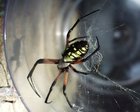St Andrew's Cross spider
|
|
| St Andrew's Cross spiders | ||||||||||||
|---|---|---|---|---|---|---|---|---|---|---|---|---|
| Missing image Aurantia_facing1.5in.jpg 1 Argiope spider | ||||||||||||
| Scientific classification | ||||||||||||
| ||||||||||||
| Species | ||||||||||||
|
A. aurantia |
The St Andrew's Cross spiders are large and spectacular spiders of the genus Argiope, also commonly called black and yellow agiropes due to the markings on its abdomen.
The genus Argiope is well distributed throughout the world, and most countries in temperate or warmer climates have one or more species, which look similar. In North America Argiope aurantia is known as an argiope, a golden orb weaver, or a golden garden spider. In England Argiope bruennichi, found only on the southern coast, is also known as the wasp spider.
The spider gained its common name for its habit of resting in its web with its legs outstretched in the shape of an X, the traditional shape of the cross of St. Andrew. The large white zigzag in the centre of its web is called the web stabilimentum and its function is unknown. The average orb web is practically invisible, and it is easy to blunder into one and end up covered with a sticky web. The very easily visible pattern of banded silk made by Argiope is pure white, and the almost maximally visible spider sitting in the center is bright yellow on a field of black. Why is this spider asking to be seen? These spiders build their webs with their centers about belt high, so they are too low for anything much larger than a rabbit to walk under. It must be an advantage to the industrious web weaver, then, for the entire assemblage to be clearly visible and a bit threatening looking. It would be an interesting experiment to see whether animals such as deer walk around them if they are on their path; if a human or other rather large creature walks through a web, then the spider's weaving job is totally demolished. And, on top of that, the spider may be accidentally stepped on and killed.
These spiders are spectacular and may be quite alarming if you aren't familiar with them, but they are not dangerous. Like most garden spiders they eat insects, and they are capable of consuming prey up to 200% of their size.
The male spider is much smaller than the female, and unassumingly marked. When it is time to mate it spins a companion web alongside the females. After it mates with the female, she then lays her eggs, places her egg sac in the web, and dies. The sac contains 400-1400 eggs. These eggs hatch in the autumn, but the spiderlings overwinter in the sac and emerge during the spring. The egg sac is composed of multiple layers of silk and designed to protect its contents from damage, but numerous species of insects have been observed to parasitise the egg sacs.
Gallery
Saint_Andrews_Cross.jpg
Aurantia_hanging.5in.jpg
Aurantia_ventral.5in.jpg
External links
- http://www.rochedalss.qld.edu.au/stand.htm (spectacular argiope photos)

